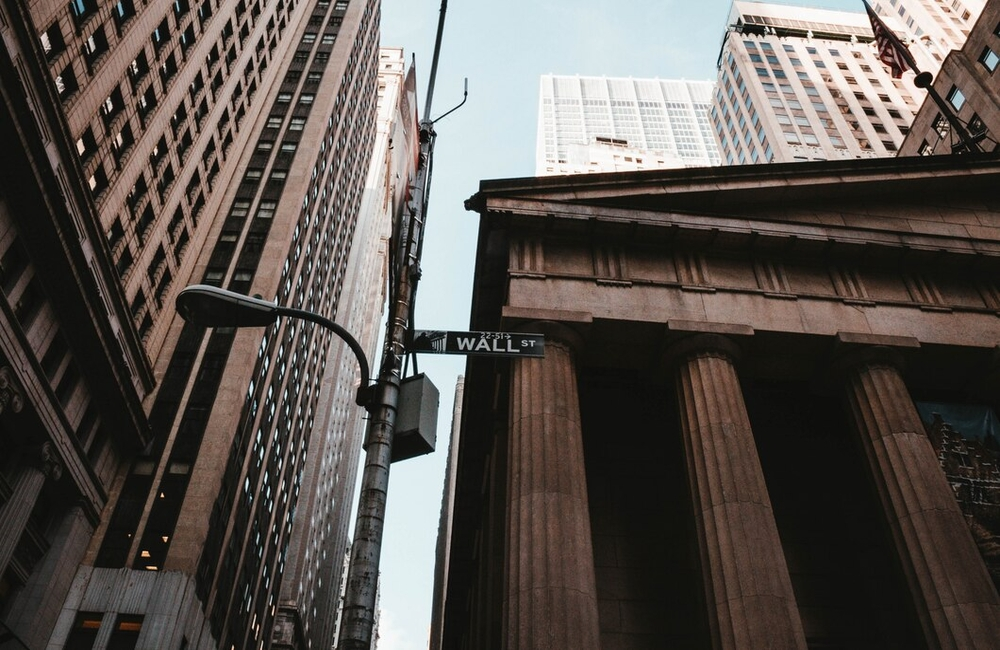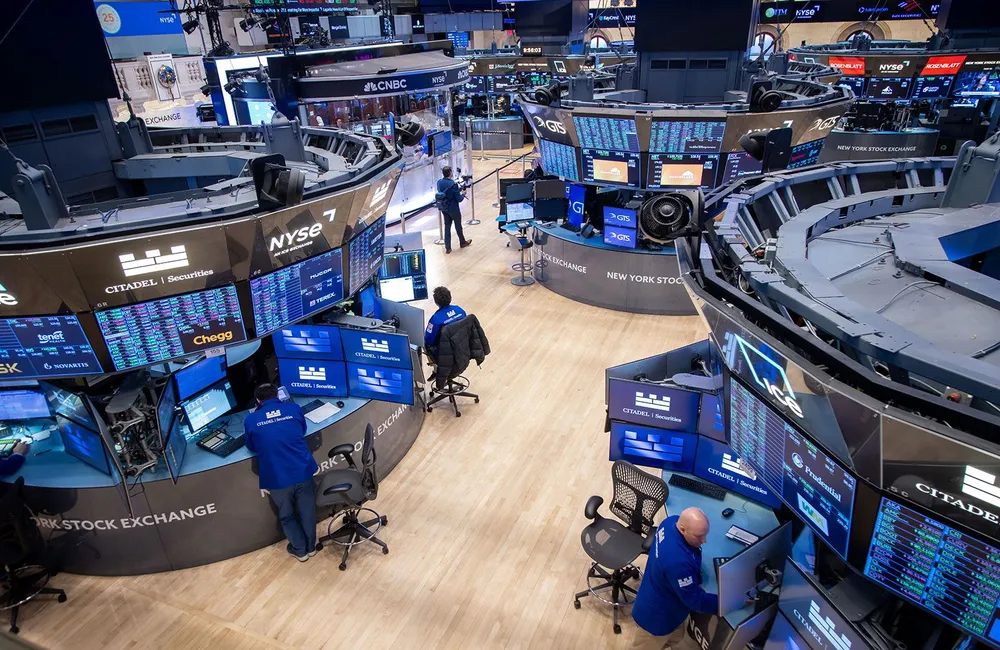ASX futures were 19 points, or 0.3% higher at 7172, as of 8.00 am AEST on Tuesday suggesting a small opening pop.
The S&P 500 rose 1.9 percent on Monday. At one point on Friday, the S&P 500 fell so much that it was poised to close at least 20 percent below its January peak, a so-called bear market before recovering. Monday’s rally gave investors a bit of breathing space. The S&P 500 is now down about 17.2% from its January high.
The Dow Jones Industrial Average was up 2% following strong earnings at major banks, while the tech-heavy Nasdaq Composite Index added 1.6%.
Financials performed best on the S&P 500, up 3.2%. JPMorgan Chase rose 6.2 percent to $124.60 after it provided updated guidance during a presentation on Monday, which offered a more favorable view of economic prospects. The bank said it will benefit from growing loans and higher interest rates.
“From a big-picture standpoint, the near-term credit outlook, particularly for the US consumer, remains strong,” Chief Financial Officer Jeremy Barnum said on Monday.
At home, the S&P/ASX 200 ended flat at 7148.9 as weakness in the financial and health sectors offset strength among commodity stocks. The broad index, which had been up as much as 0.7% earlier in the session, faded on a day that seemed to build on the last-minute momentum that helped keep the S&P 500 from closing in bear-market territory on Friday.
The banks Commonwealth, ANZ, Westpac and NAB dipped between 0.1 per cent and 0.9 per cent, while CSL's 0.7 per cent pull-back was the primary driver of the 0.2 per cent fall among health plays.
The energy sector rose 0.3% and miners Rio Tinto, BHP and Fortescue gained between 1.1% and 2.8% on rising iron-ore prices.
Elders rose 8.9% to a record of 14.92 after the agribusiness lifted its interim dividend after a strong half.
Incitec Pivot slumped 3.7% to $3.60 after it revealed plans to spin its fertilizer unit into a new company, Incitec Pivot Fertilisers, and rename itself after its mining explosive subsidiary Dyno Nobel.
In commodity markets, Brent crude oil was 0.8% higher at US$113.47 a barrel. Iron ore slipped 0.2% to US$135.95. Gold rose 0.3% to US$1858.70.
Local bonds were a touch weaker on Monday with risk appetite firmer. Yield on Australian 2 Year government bonds surged to 2.47% and 10 Year to 3.32%. Overseas was a similar story though US Treasury 2 Year notes were up at 2.62% and 10 Year rated at 2.85%. Yields rise as prices fall.
The Australian dollar was at 71.03 US cents at 7.00 am AEST, from the last close of 70.38 US cents. The Wall Street Journal Dollar Index, which measures the US dollar against 16 other currencies, fell to 94.76.
Asia
Chinese stocks finished the session mixed, giving back some of Friday’s gains when the mood was improved after the PBOC cut a key lending rate. Analysts from Essence Securities write in a note that subdued market turnover in previous sessions shows how overall buying interest continues to be low despite Friday’s bounce. The benchmark Shanghai Composite Index gained 0.29 point to 3,146.86, the Shenzhen Composite Index climbed 0.6% to 1,994.76 and the ChiNext Price Index, which tracks tech companies, dropped 0.3% to 2,410.12. The gainers were led by makers of commercial vehicles, including bus makers and truck makers, while property-related stocks, including developers, construction companies and makers of home appliances, were weaker.
Hong Kong stocks closed lower, on the market following its China counterpart lower after the two retreated from a Friday rebound powered by Beijing’s rate cut. The Hang Seng Index, the benchmark here, was 1.2% lower at 20470.06. Losses were led by Alibaba Health Information which fell 9.7% after the Alibaba-controlled firm said a shareholder transferred some of its 6.9% stake. Other tech stocks added to the market’s woes with electronics makers AAC Technologies and Sunny Optical down 6.9% and 3.3%, respectively.
Japanese stocks finished higher, regaining gains made around the opening bell as insurance companies rose after posting strong results despite higher operations costs due to uncertainty in the economy. Tokio Marine Holdings added 7.6% after forecasting a 2.3% increase in net profit for the fiscal year and announcing a share buyback. Sompo Holdings rose 7.9% after reporting a 58% increase in net profit for the fiscal year and a share-repurchase program. Investors are monitoring President Biden’s visit to Japan and shifts in the prices of crude and other commodities. The Nikkei Stock Average finished 1% higher at 27001.52.
Europe
European shares nudged higher amid talk of possible European Central Bank interest-rate increases and after an upbeat start to trading in Wall Street. The pan-European Stoxx Europe 600, French CAC 40 and German DAX rose more than 1%.
“ECB President Christine Lagarde suggested that rate hikes would commence in July, which in turn helped to boost the share prices of German and European banks and also lifted the euro to its highest level in almost four weeks against the US dollar,” CMC Markets analyst Michael Hewson says.
London’s FTSE 100 ended 1.56% higher on Monday, towering over its European counterparts. It also helped the FTSE 100 to shore up its status as a more defensive index, as basic resources and the telecoms with both performing relatively well, CMC Markets UK chief market analyst Michael Hewson says.
Vodafone notched up its second consecutive day of solid gains on news last week that Etisalat had built a stake in the company, Hewson writes in a research note. Elsewhere on the index, house builders edged up after the latest Rightmove house price index for May showed a better-than-expected gain on both the monthly and annual measure, as a lack of supply helped support prices despite higher rate fears, says Hewson.
North America
US stocks climbed, powered by the financial sector, as the S&P 500 continued to distance itself from bear-market territory after flirting with such levels during a turbulent trading session Friday.
The wide-ranging benchmark rose 1.9% Monday. At one point Friday, the S&P 500 fell so far that it was on pace to close at least 20 percent below its January peak in what would have been called a bear market before recovering. Monday’s rally provided investors some breathing space. The S&P 500 is now about 17.2 percent off its January peak.
The Dow Jones Industrial Average climbed 2 percent, buoyed by the strong results at the big banks, and the tech-focused Nasdaq Composite Index gained 1.6 percent.
The S&P 500’s 11 sectors all rose on Monday. Financials was the top performing sector, up 3.2%. JPMorgan Chase gained 6.2 percent to $124.60 after laying out updated guidance during a presentation on Monday that painted a more positive picture of the prospects for the economy. The bank said it anticipates being a beneficiary of loan growth and higher interest rates.
“So overall, credit fundamentals in the near term, particularly for the US consumer, remain strong,” Chief Financial Officer Jeremy Barnum said on Monday. Goldman Sachs gained 3.2 percent, or $ 9.81, to $ 316.61, and the KBW Nasdaq Bank Index rose 4.1 percent.
Other stocks that would do better in a stronger economy also rose. Deere climbed 7%, or $22.05, to $335.36. Caterpillar rose 3.2%, or $6.33, to $204.15. The discount retailer Ross Stores rose 9.6 percent, or $6.88, to $78.75.
Stocks have pulled back in recent weeks as investors argued over how aggressively the Federal Reserve will raise interest rates to bring down high inflation levels. Price pressures have eaten into some corporate earnings, though money managers are also concerned that tightening financial conditions too aggressively risks dampening economic growth.
In recent months, inflation fears have been elevated as China announced lockdowns intended to stop the spread of Covid-19, putting additional stress on supply chains. Russia’s war against Ukraine has also forced European countries to abandon Moscow’s oil and gas, contributing to prices.
“This year, we have a number of problems on our plate that, standalone, would normally be the top story any year,” said Hugh Gimber, a global markets strategist at J. P. Morgan Asset Management. “But the variety of these things are all hitting markets at once.” That has contributed to increased volatility, he added.
Although a 20% selloff broadly defines a bear market, a bear market itself is simply a transition in the business cycle from expansion to contraction, said Shawn Snyder, head of investment strategy at Citi Personal Wealth Management. That means for investors, the next key thing is a signal that a bottom has been reached, he said.
The bottom may not be in, Mr. Snyder said, but investors are already searching for one. It takes the market 132 trading days, on average, to move from a high to the beginning of a bear market and 213 trading days to reach the low, according to Dow Jones Market Data. Monday marked the 97th trading day since the S&P 500 peaked, so there’s a way for investors to go.
“This is one of those instances where you turn the screens off and go on vacation and hope when you come back it looks better,” Mr. Snyder said.
Among other individual stocks, shares of VMware soared 25 percent, or $23.72, to $119.43 after The Wall Street Journal reported that Broadcom is in advanced talks to acquire the technology company. Broadcom’s stock dropped $16.83, or 3.1 percent, to $526.36.
Investors will also be watching earnings from retail stocks this week for clues on the impact that inflation and the lingering effects of the Covid-19 pandemic are having on consumers. Companies including Macy’s, Dollar General and Costco are expected to report.
Macy’s rose 1.2 percent, or 21 cents, to $18.37. Dollar General rose $6.82, or 3.6 percent, to $194.42. Costco gained 3.1 percent, or $13.05, to $429.48.
In bond markets, the yield on the 10-year Treasury note rose to 2.857% from 2.785% Friday. Yields and prices are inversely related.
US crude increased 0.1% to $110.29 a barrel. Prices for gas at the pump stayed in record territory over the weekend, averaging around $4.59 a gallon nationwide.




















